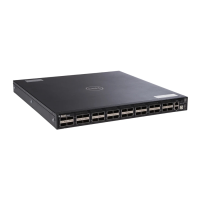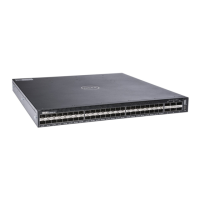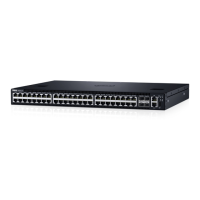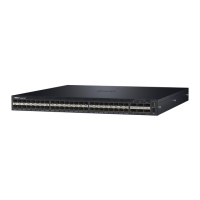hardware. S6000 platform uses the hardware chip that supports this behavior and hence they can make
use of this capability.
CLI commands are introduced to move /128 IPv6 prefix route entries and /32 IPv4 prefix route entries
from Host table to LPM table and vice versa. When moving the destination prefixes from Route to Host
table, there is a possibility of getting into hash collision because the Host table on the device is a Hash
table. In this scenario, a workaround does not exist for the user having route entries programmed in host
table.
When the command is issued, you are prompted with a warning message stating that the command
configuration can take effect on existing prefixes only when “clear ip route *” command is used. When
you use the clear command, all the existing /32 IPv4 prefix route entries are reprogrammed in
appropriate table. Also, all the other existing IPv4 entries are removed and reprogrammed as a result of
the clear command.
Dell Networking OS releases earlier than Release 9.3(0.1) stores IPv6 /128 entries in Host table since it
cannot be written in LPM table, and IPv4 0/32 route entries are written in LPM table itself to support the
ECMP since ECMP was not supported in Host table. On S6000 switches, unified forwarding table (UFT) is
enabled, and the host table size is bigger compared to the LPM. When you move the IPv4 /32 route prefix
entry in host table, more space is obtained that can be utilized for other route prefix entries.
Support for ECMP in host table
ECMP support in the L3 host table is available on S6000, S6000–ON, Z9100–ON, and S6100–ON
platforms. IPv6 /128 prefix route entries and IPv4 /32 prefix entries which are moved to host table can
have ECMP. For other platforms, only the IPv6 /128 prefix route entries is stored in the L3 host table
without ECMP support.
The software supports a command to program IPv6 /128 route prefixes in the host table.
The output of show IPv6 cam command has been enhanced to include the ECMP field in the Neighbor
table of Ipv6 CAM. The sample output is displayed as follows, which is similar to the prefix table.
The following is the portion of the example output:
Neighbor Mac-Addr
Port VId
------------------------------------- -----------------
--------- ----
[ 132] 20::1 00:00:20:d5:ec:a0 Fo
1/4 0
The following is the portion of the example output from Release 9.3(0.1):
Neighbor Mac-Addr Port Vid EC
------------------------------------- -------------------------
[ 132] 20::1 00:00:20:d5:ec:a0 Fo 1/4 0 1
[ 132] 20::1 00:00:20:d5:ec:a1 Fo 1/8 0 1
Support for moving /128 IPv6 Prefixes and /32 IPv4 Prefixes
The software supports a command to program IPv6 /128 route prefixes in the route table. You can define
IPv6 /128 route prefixes in the route table using the ipv6 unicast-host-routecommand. You can
also define IPv4 /32 route prefixes in the host table using the ipv4 unicast-host-routecommand.
312
Equal Cost Multi-Path (ECMP)
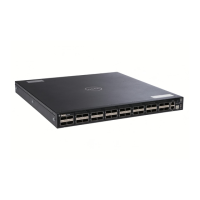
